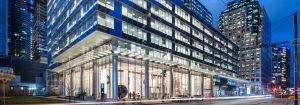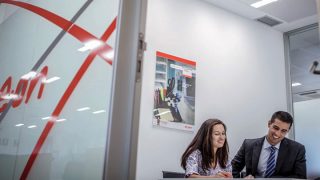Bring together a human approach with advanced technology to create an efficient and effective office space. Attract and retain the best talent with sustainable solutions that positively impact your employees’ feelings, behaviour and performance. Additionally, you can ensure that your building is IoT-enabled by using our connected luminaires in combination with Interact Office, helping you harness the power of smart technology.
Product highlights
Transform your office into an inspiring place to work
Optimise operations
Save up to 80% on energy by switching to a LED lighting and controls
Manage changing needs of occupants with flexible and upgradeable lighting
Use extensive range of luminaire forms to suit different spaces
Enhance performance
Deliver visual and emotional comfort with light scenes and personal light recipes
Create a healthy and inspiring workspace with natural light distribution
Improve employee productivity with LED lighting that is visually comfortable and suited to a specific task
Enhance engagement and wellbeing
Improve wellbeing using the benefits of natural light
Attract and retain the best employees with a healthy workspace that offers humanised technology
Support circadian rhythms with dynamic tunable white lighting that provides the right light at the right time
Explore the possibilities

Discover connected lighting
Support employee performance and reduce time wasted with Interact Office software and system architecture to help employees find free meeting rooms or an available workspace, and enable them to personalise lighting. Then use occupancy insights to see where and how people prefer to work, opening your eyes to potential for energy and space savings, and efficiency gains. Simply install LED connected lighting from Philips with embedded IoT sensors, and use Interact Office software and insights to increase building efficiency and optimise space to create a sustainable smart office.
Workplace health and wellbeing
We have become the indoor generation. On average, we spend more than 90% of our time indoors, with 36% of that spent in the workplace. But the more time we spend indoors, the less we’re exposed to the beneficial effects of light. As a consequence, we don’t receive enough nutrition from natural daylight to help us.
Do you want to know more about the biological effects of light? We have developed a white paper where you can learn about the Light has visual impact (see well), the emotional impact (feel well) and a biological impact (perform well).

Increase wellbeing in the office by applying melanopic lighting
Melanopic light is the part of biological light which plays a major role in synchronising the internal body clock in line with non-visual effects of light. When you properly design melanopic lighting in your building, it brings the benefits of natural daylight indoors, enhancing visual comfort, wellbeing and performance. Learn more about how to increase wellbeing in the office by applying melanopic lighting by reading our latest brochure on melanopic light.
Office design is changing fast. Functional workspaces are giving way to engaging and inspiring environments where people’s health and wellbeing are prioritised and supported. And that does not just improve the mood, sleep patterns and performance of everyone in the workplace; it attracts talent and retains high-value employees too.

The importance of lighting in WELL Building Certification
The International WELL Building Institute (IWBI) launched the WELL Building Standard, a global rating system designed to enhance health and wellbeing in the workplace, in 2014. V2 was introduced in 2020 consolidating all previous variations and v2 pilot into one WELL for all project types. WELL v2 responds to new evidence and changing public health concerns and is updated on a quarterly basis. Read the WELL Building Certification leaflet to learn more how to score point totals to higher levels of certification.
Lighting services
Lighting services are managed by Signify. We take care of your lighting, so you can take care of your business. Find more information about these services on our company website.

Professional services
Offering tailored support from the start, we strive to combine your ambition with our knowledge, providing the best solution for you while adding value to your business.

Lifecycle services
Your business deserves lighting that's built to last. From stopping problems before they occur to speedy remote assistance, our support will help keep your lighting system in working order for longer.

Managed services
We create lighting solutions customised to suit your business needs, in line with a clear set of Key Performance Indicators.

UV-C disinfection services
UV-C light is a known disinfectant for air, water and surfaces. To help ensure effectiveness and correct usage, we provide UV-C services for project design, planning, installation, operation and maintenance.
Case studies
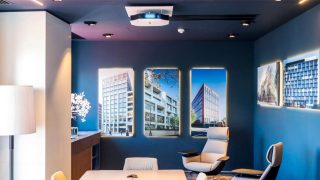
A safe return to the office for Forte Partner
In the context of the recent pandemic, Forte Partners chose UV-C disinfection lighting aiming to give their tenants the comfort to return to a safe office.
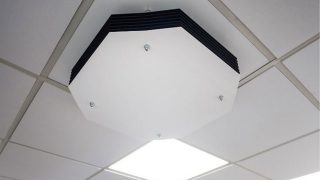
Philips UV-C Upper Air
Mašinoprojekt Kopring a.d., a construction business company, from Belgrade, Serbia, has chosen Philips UV-C Upper Air for disinfection in their conference room
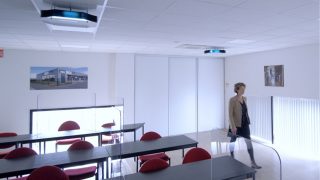
Sonepar
Sonepar Connect in Reims, France, chose Philips UV-C disinfection upper air luminaires to protect the air in their rooms against bacteria and viruses.
Want to know more?
Get in touch with your local contact centre for questions and enquiries.

